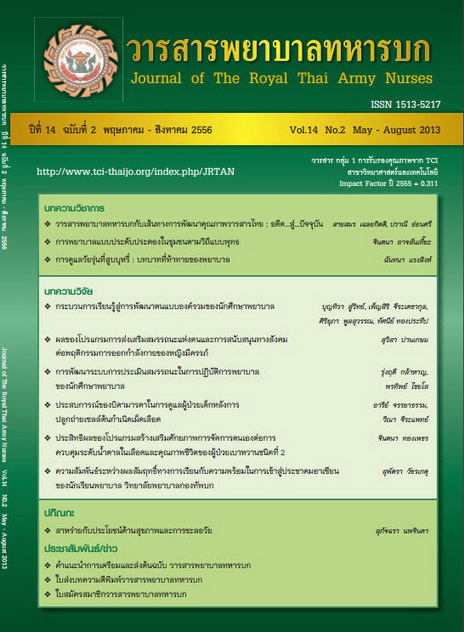การพัฒนาระบบการประเมินสมรรถนะในการปฏิบัติการพยาบาลของนักศึกษาพยาบาล The Development of a Competency Assessment System for Nursing Students’ Practicum
Keywords:
การพัฒนาระบบ, การประเมิน, สมรรถนะ, นักศึกษาพยาบาล, การปฏิบัติการพยาบาล, System development, Assessment, Competency, Nursing Students, PracticumAbstract
บทคัดย่อ
การวิจัยครั้งนี้มีวัตถุประสงค์เพื่อพัฒนาระบบการประเมินสมรรถนะในการปฏิบัติการพยาบาลของนักศึกษาพยาบาล มีขั้นตอนดำเนินการวิจัยเป็น 3 ระยะ คือ การวิเคราะห์ระบบ การออกแบบระบบ และการตรวจสอบคุณภาพของระบบ กลุ่มที่ศึกษาเลือกแบบเจาะจง ได้แก่ ผู้เชี่ยวชาญด้านการพยาบาลจำนวน 18 คน อาจารย์จำนวน 17 คน และนักศึกษาจำนวน 102 คน จากคณะพยาบาลศาสตร์ 4 แห่ง คือ มหาวิทยาลัยศรีนครินทรวิโรฒ คริสเตียน กรุงเทพธนบุรี และวิทยาลัยเซนต์หลุยส์ การเก็บรวบรวมข้อมูล ใช้การสังเกต การสอบถาม การสัมภาษณ์ การสนทนากลุ่มย่อย และการวิเคราะห์เอกสาร การวิเคราะห์ข้อมูลใช้การหาค่าความถี่ ค่าร้อยละ ค่าสหสัมพันธ์เพียร์สัน และทดสอบความแตกต่างของค่าเฉลี่ยด้วยการทดสอบ t-test
ผลการวิจัยพบว่า
1. องค์ประกอบของระบบการประเมินสมรรถนะในการปฏิบัติการพยาบาลของนักศึกษาพยาบาล ประกอบด้วย 1) ปัจจัยนำเข้า 2) กระบวนการ และ 3) ผลผลิต
2. ผลการตรวจสอบคุณภาพของระบบ จากการนำระบบที่พัฒนาขึ้นไปทดลองใช้ พบว่า ระบบมีคุณภาพตามเกณฑ์มาตรฐานการประเมินทั้ง 4 ด้าน คือ 1) ด้านความเป็นไปได้ พบว่า ระบบใช้ได้จริง สารสนเทศจากการประเมินเป็นที่ยอมรับ และมีความคุ้มค่าต่อผู้ใช้ผลการประเมิน 2) ด้านความเหมาะสม พบว่า ระบบได้ดำเนินการตามกฎ ระเบียบของสถาบันการศึกษาที่เป็นแหล่งทดลองใช้ระบบ 3) ด้านความเป็นประโยชน์ พบว่า ได้ข้อมูลป้อนกลับที่นักศึกษานำไปใช้ในการปรับปรุงพัฒนาสมรรถนะอย่างต่อเนื่อง ผลการประเมินความก้าวหน้า และการประเมินสรุปรวม พบว่านักศึกษาร้อยละ 95.09 และ 99.02 มีคะแนนพัฒนาการเพิ่มขึ้น ตามลำดับ 4) ด้านความถูกต้อง พบว่า ผลการประเมินความก้าวหน้าและการประเมินสรุปรวม มีความสอดคล้องกันระหว่างผู้ประเมิน 2 คน ค่าสหสัมพันธ์เพียร์สันระหว่างผู้ประเมิน มีความสัมพันธ์ทางบวกในระดับสูงอย่างมีนัยสำคัญทางสถิติที่ระดับ 0.05 (r= 0 .71- 0.99)ABSTRACT
The main objective was to develop a competency assessment system for nursing students in the practicum area. The study was divided into three phases as follows: 1) Analysing the system 2) Designing the system, and 3) Testing the quality of the system. The sample were taken by purposive sampling.The group of this study consisted of 18 experts in nursing science, 17 instructors and 102 nursing students from 4 universities namely Srinakharinwirot, Christian, Bangkokthonburi and Saint Louis College. The data was collected by using various methods: observation, questionnaires, interview, focus group and content analysis. Frequency, percentage ,Pearson product- moment correlation and t-test were conducted to analyze the quantitative data.
The research results found that
1. The competency assessment system for nursing students’ practicum consisted of 3 key components were 1) Input 2) Process and 3) Output
2. Regarding the outcomes of the implementation, the study found that the system possessed quality in 4 standards: 1) Feasibility standards, the system could be practicable in nursing curriculum. 2) Propriety standards, the system was considered to be correct and acceptable to implement by the right rule and ethics. 3) Utility standards, students appreciated feedback on their performance which help them develop their competencies. Based on the results of formative and summative evaluation, 95.09 and 99.01 per cent of the students achieved higher scores respectively. 4) Accuracy standards , formative and summative evaluation scores were congruence of evaluation between 2 evaluators. There were also positive relationships between evaluators with statistical significant difference at 0.05 (r= 0.71 - 0.99).
Downloads
Downloads
Published
How to Cite
Issue
Section
License
บทความหรือข้อคิดเห็นใดใดที่ปรากฏในวารสารพยาบาลทหารบกเป็นวรรณกรรมของผู้เขียน ซึ่งบรรณาธิการหรือสมาคมพยาบาลทหารบก ไม่จำเป็นต้องเห็นด้วย
บทความที่ได้รับการตีพิมพ์เป็นลิขสิทธิ์ของวารสารพยาบาลทหารบก
The ideas and opinions expressed in the Journal of The Royal Thai Army Nurses are those of the authors and not necessarily those
of the editor or Royal Thai Army Nurses Association.






